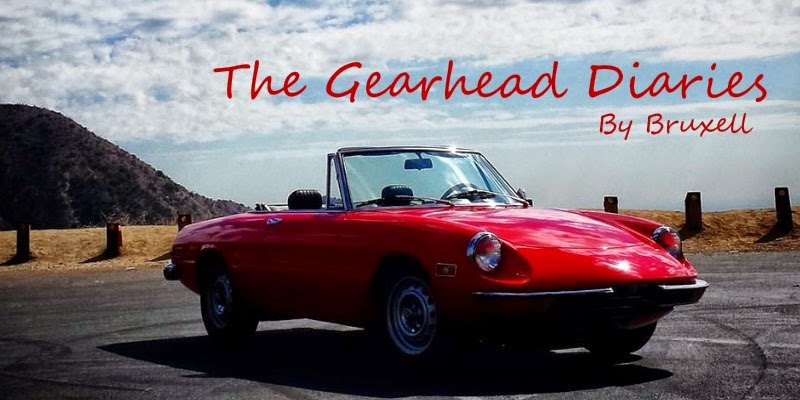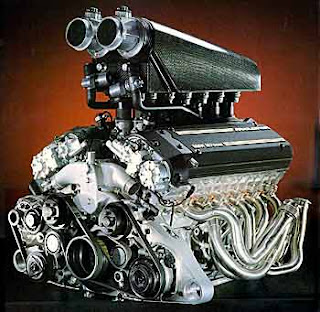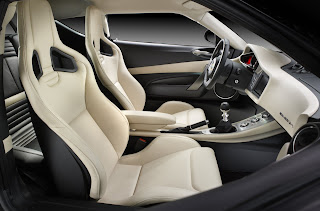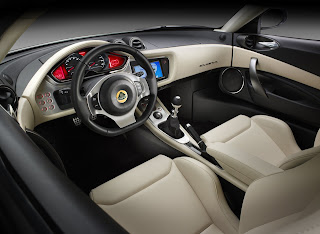
My first post on this trifle of a blog was a wordy little grump about Honda jumping into the fray with a car that promised to be based less in the philosophy of driving enjoyment, and more in the camp of the extreme performers. It's a disturbing trend that I see all over the industry these days,on e countered only by the likes of Lotus with their flyweight Elises and Exiges. It's a trend that seems to have its roots in Germany's Eiffel Mountains, and that most famous strip of dangerous tarmac, the Nurburgring.
In truth I think even the ring is only a symptom. The public has little understanding of the benefits of light-weight sports cars, and those cars are gradually being regulated out of existence by increasingly draconian safety and emissions laws. Combined with a market that thinks their cars are supposed to be mobile living rooms those laws make sports cars under 3,000lbs a rare sight these days. So, if the already hard to quantify quality of driving enjoyment is also increasingly difficult to produce, who can blame manufactures for generating headlines by turning up the power and using computers to stand in for driver ability in an effort to put real speed in the hands of the masses?
Me, that's who. I'm sick of it. I'm sick of watching cars that should weigh two thirds what they do fly around tracks at break-neck speeds, consuming huge quantities of high-test gasoline. I'm sick of the mantra of speed at all costs, and I'm sick of people buying cars they can't be bothered to learn to drive properly while producers cater to them with stability control programs, and all-wheel-drive systems that stand in for the ham-fisted control in-puts of today's "sports car" buyer. I can't stand to watch the label sport attached to machines that have had all sporting integrity programmed out of them in the name of shaving precious seconds of their lap-times on the world's most exciting toll-road.
And so it is that I've had a change of heart in recent years, or maybe there's been a convergence of philosophy; I've decided that I rather like the Chevrolet Corvette. It's been a long, slow road, to such a fast car. Don't get me wrong, I've always loved the older Sting Rays with their out of this world style and mechanical fuel-injection. I like the 50s cars as well, and I've always thought that the '68-'72 cars made for attractive, and reasonably priced sportsters, at least before the market went through the roof.
Truth is though, the Corvette and I, at least at the more extreme ends of the performance scale, go our separate ways in 1966, with the arrival of the Big-Block. I am not a fan of Big-Blocks. In fact, they are the antithesis of performance in my mind. They don't really achieve anything out of the ordinary for an engine, they just do what any engine does on an enormous scale, and they have no place in a car like a Corvette. Because of the Big-Block, and their lock on the American enthusiast's mindset, I grew up think of the Corvette as an agricultural, and very heavy pseudo-sport. Factor in the decline of the entire US auto industry in the 70s and from 1967 to the present day only one car had any impact on my perception of "America's Sports Car" as being a well intentioned myth.
That car was the C4 ZR-1 of the late 80s and early 90s. With its Lotus developed, DOHC, 350ci LT5 V8 that developed between 375 and 405bhp over its lifetime, the ZR-1 was a Corvette apart. It wasn't the performance that made the car different for me, it was the way the car went about going fast. Here was a Corvette with the specification I craved.
I still get excited when I see one, but not enough buyers shared my fascination and the car was a sales dud. It did succeed in generating interest in the Corvette range, and was an image builder for Chevy as a whole, but the car was over-priced. It didn't help that, other than the monster motor, there wasn't a lot of difference from the regular L98 engined Corvette, and once the asthmatic L98 had been replaced with the muscular LT1, there was even less. Sure, if you looked c lose you might notice the swollen rear arches housing tires wide enough to deploy all that power, and if you sat in the cabin, you might be able to see past the bits falling off long enough to notice the switches for the adjustable damping system. But you had to look hard, and most people couldn't tell the difference anyway.
And so it was that I lost interest again. The Corvette and I seemed destined to sail a different course. I think would have missed the C5 update entirely,, trans-axle gearbox included had it not been for the introduction of the Z06 model. Even that car proved to be only about two thirds of what was needed, bringing the Corvette only up to the level of interesting high-performer for those who wanted something that wasn't a Porsche 911. The C6 introduction though, that got my attention. First there was the news that this Corvette would do something Corvettes just didn't do in my experience, it would shrink.
That's right, the Big, Bad Chevy got... not as big, and with that move weight was kept down. Clearly someone was on an interesting tack here and when the news of the revised Z06 broke the spec sheet read like no American production car before. Carbon fenders, aluminum chassis, magnesium roof structure, Chevy were breaking new ground. Then there was the engine; no, it hadn't sprouted overhead camshafts or 32 valves, but what it did was somehow cram all the displacement of a 427 big-block into the external dimensions of a 350. It generated 505bhp and was lighter than the the Old LT1 (Chevy had supplanted that motor with the Aluminum LS1 in 1997). Chevy then went about demonstrating that they were sweating the details by mounting the engine lower, and further back in the chassis to improve the distribution of what weight was left. I didn't even blame GM for demonstrating their new found savvy by lapping the Nurburgring in search of a competitive time.
Now there's a new ZR1, with a supercharger, 638bhp, and an even more extreme chassis. It's lapping the Ring at 7:26, three seconds faster than Nissan's reinvented GTR. It's got a top speed of 205mph as well, but somehow, this time, the ZR1 and I just aren't playing for the same team. I find myself wondering what could have been if Chevy had stuck to the philosophy they employed so well with the Z06 and made the car even lighter. What if they made it rev higher, and used the ZR!'s carbon-fiber roof to make the car even lighter? What if they had spent the money they used to develop the supercharged LS9 engine on making a coil-sprung suspension would respond even better than the Z06's?
It probably wouldn't lap as quickly, that's what. In the current climate where performances is all that the public responds to the ZR1 makes sense, and it will be a fitting flagship. It's still my favorite of the forthcoming baby super cars too. I just wonder what the world will make of it in 20 years, when we look back, will we see it as a classic icon, or a wasteful dinosaur that, perhaps like the industry as a whole, failed to change with the times.
 The Mastreta MXT is notable for being light weight, small, quick, and -relatively- cheap. It's also notable for being the first native born car from Mexico. It's a small sports car, though because it weighs only 900kg its performance is more super than sports, with 0-60mph taking under 5-seconds. It's not slow flat-out either, though 150mph is merely fast-hatch territory anymore. It may not be cute exactly, but its aggressive stance and chunky proportions aren't without appeal, but the way the front and rear halves come together at the roof needs attention.
The Mastreta MXT is notable for being light weight, small, quick, and -relatively- cheap. It's also notable for being the first native born car from Mexico. It's a small sports car, though because it weighs only 900kg its performance is more super than sports, with 0-60mph taking under 5-seconds. It's not slow flat-out either, though 150mph is merely fast-hatch territory anymore. It may not be cute exactly, but its aggressive stance and chunky proportions aren't without appeal, but the way the front and rear halves come together at the roof needs attention.  If all this is beginning to sound just a bit like a Lotus Elise, you're really not that far off, at least in concept; and indeed, the MXT shares the little Lotus' features of a bonded aluminum chassis, and fibreglass body. It does without the Lotus' extreme take on the subject though, with an air conditioned, leather-trimmed cockpit. Add in its Ford Duratec power plant, and, too me, it reminds more of an Italian sports car of yore, the De Tomaso Vallelunga. And that can only be a good thing.
If all this is beginning to sound just a bit like a Lotus Elise, you're really not that far off, at least in concept; and indeed, the MXT shares the little Lotus' features of a bonded aluminum chassis, and fibreglass body. It does without the Lotus' extreme take on the subject though, with an air conditioned, leather-trimmed cockpit. Add in its Ford Duratec power plant, and, too me, it reminds more of an Italian sports car of yore, the De Tomaso Vallelunga. And that can only be a good thing. Ok, so I'm hoping that the new car does without the Vallelunga's ear-splitting noise levels, or it's flaky build quality. But if the car turns out to be half the handling paragon the littlest De Tomaso was, then Mexico will have done itself proud, especially as this is the kind of car for which Italy used to be famous, but which has been washed away in the past three decades beneath a wave of ever faster super cars.
Ok, so I'm hoping that the new car does without the Vallelunga's ear-splitting noise levels, or it's flaky build quality. But if the car turns out to be half the handling paragon the littlest De Tomaso was, then Mexico will have done itself proud, especially as this is the kind of car for which Italy used to be famous, but which has been washed away in the past three decades beneath a wave of ever faster super cars. Production will be limited as well with a mere 150 vehicles produced in the first year, with 80 of those being RHD. The price in Britain is expected to be around £40,000. Of course, US customers won't get the car at all as there are no current plans to certify it for sale in the market. I am though, really excited for this car, but I'm a bit concerned that the person shooting the video of the car testing could be bothered/afford to use a tripod... Still, it's a great start, and who knows, it may lead other sports car manufacturers in the right direction. Definitely one on which to keep an eye.
Production will be limited as well with a mere 150 vehicles produced in the first year, with 80 of those being RHD. The price in Britain is expected to be around £40,000. Of course, US customers won't get the car at all as there are no current plans to certify it for sale in the market. I am though, really excited for this car, but I'm a bit concerned that the person shooting the video of the car testing could be bothered/afford to use a tripod... Still, it's a great start, and who knows, it may lead other sports car manufacturers in the right direction. Definitely one on which to keep an eye.







































